
It’s funny how things happen by chance. This months entry is a bit like that. I thought it was about time I made use of some of the footage that we have of the college’s Tywarnhale mine in Cornwall, when I looked at the label on the tapes I noticed that it was 30 years ago this month, April 1980 that I went down to Cormwall. The mine and surrounding land (purchased in 1909/11 with extra land purchased in 1912) was sold by Imperial in about 2005. Here’s a BBC Cornwall web page about the sale dated 15th October 2005. As we couldn’t find any real photos of it in the college’s archives, the picture of the RSM sign is from one of the videotapes I shot. Here’s a brief history of the mine from the “Cornwall Calling” website. Please click on MORE to continue..
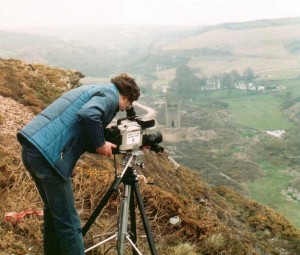
The videos you’ll see were all shot about 9 months after we received our new colour portable recording equipment. This all sounds amazing, but the early equipment was not a camcorder like the ones used now. It was a camera connected to a stand-alone videorecorder, and that was a heavy piece of kit and so was the camera. The entire unit ran from what are called sealed lead acid batteries and were the main cause of it all being so heavy (a bit like a car battery but smaller). To make matters worse, these batteries were in both the camera and recorder. If you look at the photo you’ll see a small black box at the back of the camera containing one of these batteries.
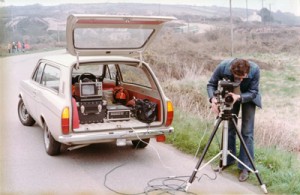
Shooting video underground was a new experience for me and former colleague Stephen Bell who come back to help me out for the few days we were down in Cornwall. We needed to hire battery lighting and create a way to protect the equipment (which of course was brand new) from the various elements we faced: water dripping down, heat and of main concern, humidity. A way was found to wrap equipment in polythene, but allow a way to operate it without unwrapping it! We found dry areas to park the recorder and run out an extension camera cable to where I was located. In most cases the cable ran in deep water from point a to point b and this photo gives an idea of what we took with us and how it connected together.
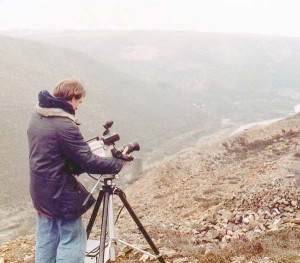
When speaking with Steve about this blog he mentioned that this was the first time he’d ever seen the ‘humidity’ light illuminate on a videorecorder. Indeed this happened several times when underground and, because of moisture, we had to remove videotape that was stuck to the video head drum. Needless to say, these tapes were then useless, so we lost a good few recordings. It’s also rather difficult trying to take the lid off of a video recorder when you’re underground and trying to see what you’re doing with a miner’s lamp on your helmet being the only source of light! Jumping forward to this year, 2010, it’s been a struggle with some of the U-matic tapes making them playback correctly. Time has not been too kind to them and all the problems underground didn’t help (moisture). But, they’re all now backed-up onto DVD from where these clips have now come.
This first video sequence is taken from the car being driven by Steve. I’m hanging out of the car window with a very large and heavy camera. You’ll also notice that this, and all other shots, will look a bit ‘soft’ and almost ghostly. This is because our very early colour camera had what is called a Vidicon tube inside it. These camera tubes required large amounts of light to get good pictures. As you’ll see, the weather was not brilliant and was very misty. None of this helped the situation. Thus the shots are rubbish compared to material shot these days. This video shows the original college buildings along the entire site.
This next video shows: students walking along the road along side the mine; Dr Thomas explaining how to use various instruments; a student entering the mine via ladder down the vertical shaft and two sequences showing students working underground. Now, it’s worth remembering that Steve and I had to enter via this same entrance carrying all of our equipment. We did have help, but camera, recorder, tripod, lights and spare batteries & tapes are difficult to carry when going down a vertical ladder! And, of course we were kitted out with the same outfits with: boot; helmet and safety lights etc. We all came out at the end, more than a bit dirty and very wet indeed.
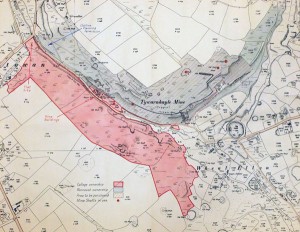
The original 1911 purchase document says that the purchase was to “…enable the Professors and Students of the college , including the Royal School of Mines, to use the levels, above adit level, of the South Towan Mine in the manor of Tywarnhaile…” There are two interesting things I’ve spotted in searching for this information, one is the spelling of Tywarnhale. I’ve found three versions: Tywarnhale, Tywarnhaile and Tywarnhayle. But I’ve gone with the version as seen in the photo of the sign that was outside the main building. Also, in the original document it’s referred to as South Towan Mine not Tywarnhale. If you know any more on this matter we’d love to know so we can get the history correct.
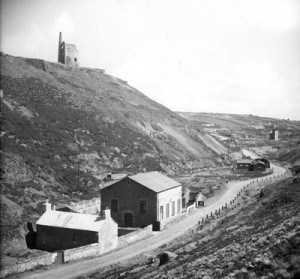
There are very few photos of the mine in the college archive, so, if you have any that you would like to donate or would allow to be copied, then Anne Barrett, of the College Archives, would love to hear from you. And, as always it’s thanks to her for sourcing the material that we do have available. It’s very lucky that the video footage was shot and that we have at least some record of our former students working in it. If YOU are one of those shown in the videos then please do comment, we’d love to hear from you. It’s been interesting to run through all these tapes again after these 30 years and remembering all the major technical issues we had to overcome. But not too pleasant remembering how wet it was underground and how the weather was typically UK that week. These recordings are a perfect example of what archiving is all about, remembering our past and our history. The fact that this ‘outpost’ was part of Imperial College from 1911 until about 2005 is something that most people are simply unaware of.
Oh and one last thought….I thought it was an old Tin mine, but all other references seem to say that it was Copper…..30 years have certainly confused me!
Colin Grimshaw April 2010 (updated 2016)
In 2016 Michael Hulmes added this useful comment to the blog post:
The guy swinging on the rope, in white overalls and blue undershirt in the underground video is Geoff Perry. I suspect his colleague with his back to the camera is Paul Dayton-Lewis. The red haired guy in the video being instructed by Dr Thomas is Philip Sharman. All were in the Mining Engineering class which spent six weeks at Tywarnhale through easter 1980
Gosh! That takes me back a bit but I remember it well.
Colin neglects to mention this was not a project for anyone suffering from claustrophobia. The underground passage to the working area was not high enough to stand straight, it was a long walk and about 18 inches deep in water. Of course, apart from the helmet lamps, it was also dark!
All that equipment Colin mentioned had to be carried a considerable distance underground whilst bent almost double and wading through water. It was hot, humid, wet and everyone and everything came out of the mine stained orange.
Yes, we suffered for our art in those days, but it was fascinating and I wouldn’t have missed the experience.
I remember having the thought as we first turned on the battery lights for the video, it was certain that area had never seen as much light since the dawn of time!
Steve Bell.
I’ve had a lovely email from Professor John Monhemius (Dean of the Royal School of Mines 2000-2001), who (although now retired from Imperial) has sent me some interesting extra facts to add to this blog entry, so many thanks John:
“…What I do know is that the mining students went to Tywarnhale every Easter vac in their second year for five weeks to do their underground surveying course. The landladies of Porthtowan used to look forward to the annual invasion of RSM students, who helped to fill their empty boarding houses before the holiday season began. The local pubs, of course, also did very well when the RSM students arrived and beer consumption went up dramatically!
Your confusion over tin and copper is understandable. Like many Cornish mines, Tywarnhale produced both these metals at different times. In the 18th century, the UK was the world’s biggest copper producer and all the copper ore used came from mines in Cornwall and Devon. Eventually these mines ran out of copper ore and we began to import it from places like Chile, brought in by sailing clippers. Meanwhile in order to stay in business, the Cornish mines switched to producing tin ore, of which there was plenty in Cornwall. However, eventually even that ran out and the last operating tin mine in Cornwall, South Crofty in Camborne, finally closed down just before the Millennium. So now Cornish mining is just a memory, until perhaps some future time when metal prices are high enough to make it worthwhile reopening some of the old mines to scavenge the lower grade materials that were left in place by the old miners, because it was not economic to extract them then.
Hope this helps a bit. Good luck with the video archive – I think it is a great idea…”
Seems like that was quite the odyssey. I would be a bit scared to go into those mines since I’m scared of enclosed places. But thank you for sharing your journey.
We are the new owners of the site. Penhale Estates Ltd.
I hope you found this blog entry interesting. Do please feel free to upload any photos you may have of the location as it is today. Its all part of the history of the area!
I should add a note that the spelling of the name can be found in two ways Tywarnhale and also Tywarnhayle. I’m not sure when or why this difference happened.
Royal College of Science Zoology undergrads also used the mine for marine field courses – above ground of course. My field course was in 1980 and we used the mine’s buildings for lab space. Fond memories.
Hi, there are a couple of 1950’s photos of rsm at Porthtowan on a facebook site called “Porthtowan and Towan cross book” posted on 30th Oct’ ’14.
Thanks Gordon for that interesting comment and addition to the story. The direct Facebook link is:
https://www.facebook.com/pages/Porthtowan-and-Towan-Cross-book/538000312962929
That take me back – loved the surveying but my triangles never seemed to meet on paper afterwards!
Mike Mason 1974
The guy swinging on the rope, in white overalls and blue undershirt in the underground video is Geoff Perry. I suspect his colleague with his back to the camera is Paul Dayton-Lewis. The red haired guy in the video being instructed by Dr Thomas is Philip Sharman. All were in the Mining Engineering class which spent six weeks at Tywarnhale through easter 1980.
Excellent and thanks for the added information, it always helps! Hope this brought back some memories for you.
I was fortunate enough to have 2 six week sessions at Tywarnhale b y virtue of repeating my second year Mining Engineering course in the 1960s. I eventually graduated in ’66. In those days we still used carbide lamps underground although I think electyric cap lamps would shortly be introduced, Our porincipal lecturers at the time were Doctor Thomas, Walter Stepec and Dave Sutton as I recall it. The six week surveying course was enormously comprehensive and we left college immediately able to contribute to a m ine’s surveying department
I have very fond memories of my two Tywarnhale stints and of the local Porthtowan and St Agnes hostelries with beer ar 1s6d a pint. Happy days.
Thanks for your memories and feedback.
Great to see, I was there in 1958/59, not much change. An appalling decision closing down the mining program. The mine was a great teaching location. I have visited Porthtowan a number of times to recall the good times during the survey class. I have the hand drawn map on my wall, best thing I did as a student there.
It’s wonderful to reflect on those times. It’s incredible how much remains the same but also a shame about the mining program—such a valuable resource for learning and hands-on experience. Porthtowan beach holds a special place in my heart too; I’ve returned a few times to reminisce